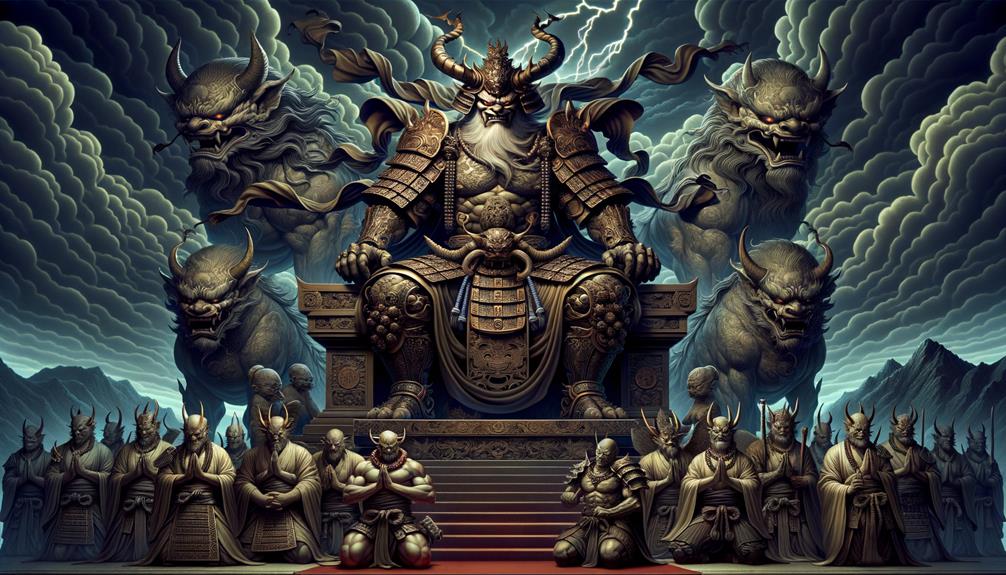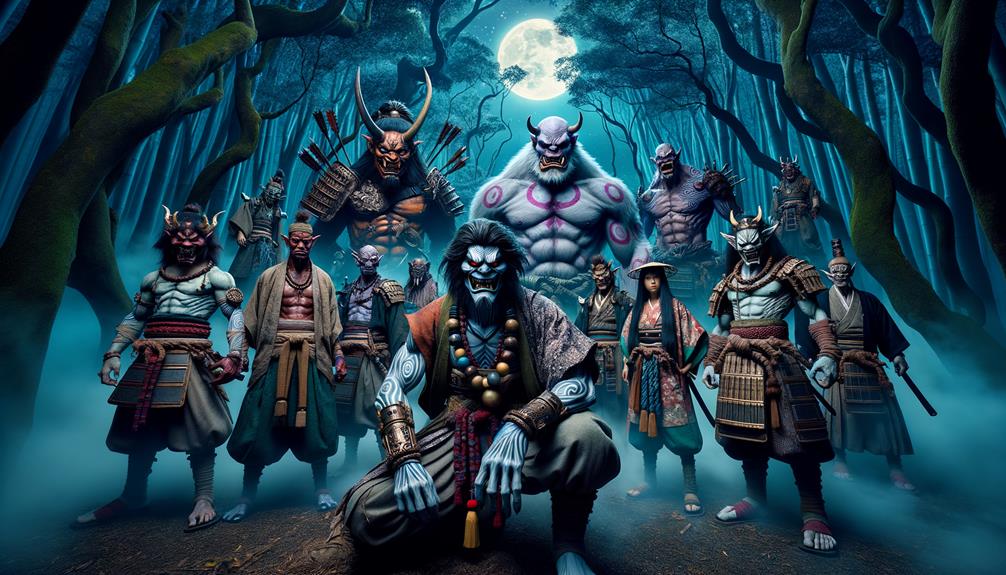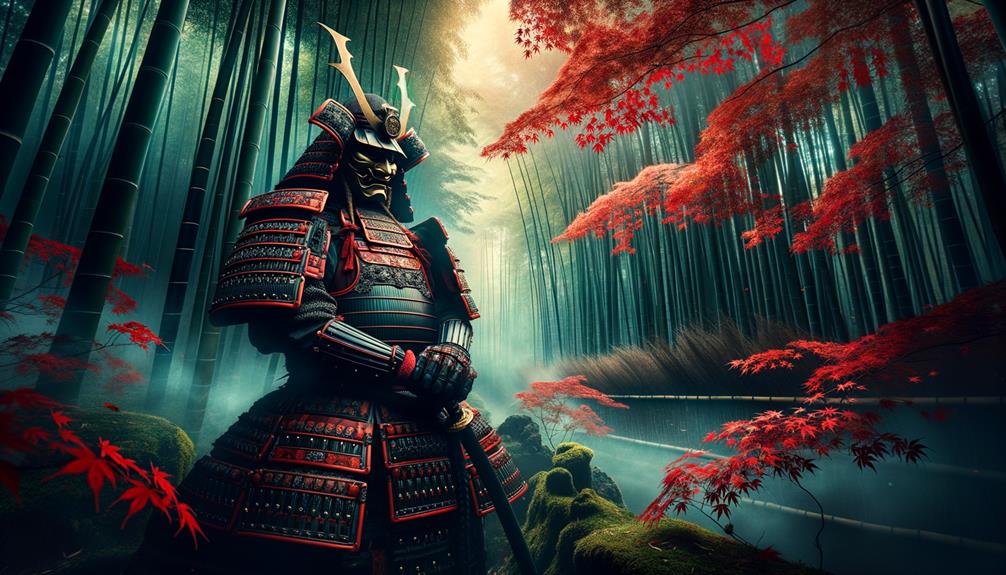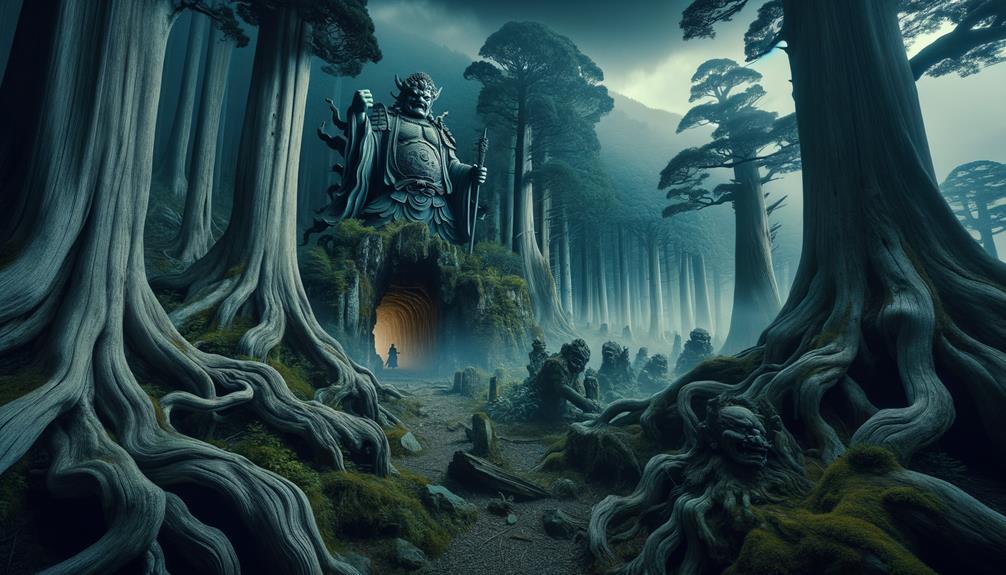Shoten Doji's tale is no dusty folklore – it cuts to the heart of power's seductive allure and corruption's insidious pull. This dreaded oni leader's origins remain shrouded, fueling curiosity about evil's genesis and twisted ambition. His dark rise mirrors humanity's darkest impulses, personifying our collective shadow self. Yet what truly captivates is his ultimate downfall, a cautionary parable of hubris laid bare. So why did Shoten Doji's towering might crumble?
Origins of Shoten Doji
Conceived from the union of a human mother and the dreaded dragon Yamata-no-Orochi, Shuten Doji's extraordinary parentage paved his path to becoming a formidable demigod. During childhood, Shuten exhibited exceptional strength and intellect, traits that distinguished him from regular humans. However, his unique ancestry made him an outcast, fueling resentment as society ridiculed him.
As Shuten matured, his contempt for humanity intensified. His fondness for alcohol earned him the nickname 'Shuten' or 'Little Drunkard,' further alienating him. Feeling ostracized, he retreated to Mount Ōe, finding solace among supernatural beings often labeled demons. There, he assembled a gang of oni and yokai.
In this new environment, Shuten's darker inclinations thrived. His intelligence and might, once potential assets, transformed into tools of terror. He led his band in vengeful raids against Kyoto, setting the stage for an inevitable clash with Minamoto no Yorimitsu and his legendary downfall.
Rise to Power

Shuten Doji's journey from a mischievous demon child to the feared leader of a formidable criminal faction exemplifies the allure of dark power. His unmatched physical abilities and sharp intellect enabled him to outmaneuver foes, while mastering black magic rituals captivated followers from society's fringes.
Relentless banditry, kidnappings, and disturbing rituals amplified Shuten Doji's infamy, cementing his dominance over Kyoto's noble families who lived in terror. The tales often culminate in his fabled clash with the warrior Yorimitsu, symbolizing the eternal struggle against evil's seductive influence.
Key factors propelled Shuten Doji's ascent:
- Formidable Strength and Cunning: Overcoming adversaries through brawn and wits.
- Mastery of the Dark Arts: Harnessing arcane rituals to enthrall a devoted criminal following.
- Reign of Terror: Instilling fear through ruthless acts against the nobility.
- Legendary Confrontation: The iconic battle pitting good against evil personified.
Shuten Doji's transformation from trouble-maker to malevolent overlord highlights humanity's perpetual struggle against the temptations of unchecked power.
Shoten Doji's Gang

Shoten Doji's crew is a dark bunch, led by powerful demons like Ibaraki-doji. Each one plays a vital role in their reign of mayhem. Their structure mirrors a twisted court, with Shoten Doji at the top, masterminding kidnappings and chaos from Mount Oe. This infamous gang embodies the villainous horde archetype, setting the stage for the heroic Minamoto no Yorimitsu to confront them.
Gang's Hierarchical Structure
In Shuten Doji's gang, a rigid hierarchy reflected the dynamics of a tyrant and his subordinates, with Shuten Doji firmly in control over lesser oni and yokai. His power went unchallenged, breeding fear and obedience among followers. The gang operated like a well-oiled malevolent machine, members carrying out Shuten Doji's orders to terrorize Kyoto and spread chaos.
This hierarchy ensured Shuten Doji's vision unfolded ruthlessly. Lesser oni and yokai weren't mere underlings; they were instruments through which chaos manifested. Roles reflected unique strengths, collectively upholding the gang's terrifying grip on the region.
The structure:
- Shuten Doji: The undisputed, all-powerful leader.
- Lieutenants: Powerful oni acting as Shuten Doji's enforcers.
- Elite Yokai: Specialized in sowing unique forms of terror.
- Foot Soldiers: Lesser oni and yokai handling essential, if mundane, tasks.
This rigid structure allowed Shuten Doji to maintain absolute control and reign of terror.
Key Members' Roles
Among Shuten Doji's inner circle, Ibaraki-doji stood out, blending fierce loyalty with cunning strategies, amplifying the gang's reign of terror. Her ferocity and tactical brilliance complemented Shuten Doji's leadership, making her a force to be reckoned with in their operations. Not only did Ibaraki-doji devise terrifying schemes, but she executed them with ruthless efficiency.
In stark contrast to Ibaraki-doji's ferocity was the legendary samurai Watanabe no Tsuna, whose encounter with her marked a pivotal moment in mythological history. Tsuna's bravery and skill in facing Ibaraki-doji highlighted the formidable nature of the gang and the power they wielded in terrorizing Kyoto.
Alongside these figures, Usui Sadamitsu and Sakata no Kintoki brought distinct strengths to the collective. Usui Sadamitsu's strategic acumen and Sakata no Kintoki's unmatched physical prowess exemplified their roles, making them essential in orchestrating and executing the gang's heinous operations. Each member's unique abilities contributed to a well-rounded and terrifyingly efficient group, solidifying their place in legend.
The synergy of these characters, blending ferocity, cunning, and strategic prowess, cemented Shuten Doji's gang as a formidable force in mythological history.
Infamous Activities Overview
Shuten Doji's gang of oni and yokai terrorized Kyoto with ruthless criminal activities and dark magic, instilling widespread fear. This malevolent group, led by the nefarious Shuten Doji, gained notoriety for their heinous crimes:
- Plundering Supplies: The gang stole alcohol and food, causing shortages that distressed locals.
- Abducting Noblewomen: Young women from noble families were kidnapped for gruesome rituals, amplifying the terror.
- Rampant Destruction: Their violent rampages left a trail of destruction, disrupting Kyoto's peace and safety.
- Employing Dark Arts: Shuten Doji and followers used dark magic to bolster their reign of terror.
Recognizing the dire situation, the legendary hero Minamoto no Yorimitsu devised a cunning plan with valiant companions. Employing magical poison, they defeated Shuten Doji, ending the gang's horrific reign. This act showcased Yorimitsu's bravery while highlighting the inevitable downfall awaiting those engaged in such malevolence. The Shuten Doji legend endures as a timeless tale of good triumphing over evil.
Legendary Defeat

With a clever strategy and a potent magical toxin, Minamoto no Yorimitsu and his brave companions overthrew the notorious Shuten Doji. Minamoto, a legendary warrior, tactically employed the magical poison to weaken the oni leader, enabling the final confrontation. Shuten Doji, infamous for his reign of terror, succumbed to this calculated assault. Even after defeat, his severed head continued snapping, showcasing his monstrous nature. To prevent his return, Shuten Doji's head was buried far from his body.
| Element | Description | Significance |
|---|---|---|
| Legendary Warrior | Minamoto no Yorimitsu | Orchestrated the strategic defeat of Shuten Doji |
| Magical Toxin | Used to impair Shuten Doji | Pivotal in making the defeat achievable |
| Head Biting | Shuten Doji's severed head continued snapping | Highlighted the persistent threat of the oni |
| Nariai-ji Temple | Where the poison was guarded | Ensured Shuten Doji's permanent downfall |
This triumph ended Shuten Doji's terror over Kyoto and neighboring regions. The strategic use of the magical toxin, safeguarded at Nariai-ji temple, guaranteed that Shuten Doji's defeat was not only momentous but also final.
Cultural Impact

Shuten Doji's mythical persona has withstood generations, transcending folklore to shape contemporary storytelling. As an embodiment of chaos locked in eternal conflict with order, this archetype resonates profoundly within Japanese culture. Ancient tales and modern adaptations alike tap into Shuten Doji's symbolism, exploring the nuances of heroism and villainy through an iconic lens.
The enduring impact of this figure underscores society's fascination with tales of good triumphing over evil. Shuten Doji's role as the ultimate adversary provides a canvas for contemplating morality and the sacrifices demanded by honor. Each retelling offers fresh perspectives on this timeless narrative, solidifying its relevance across eras.
Folklore and Modern Media
The ancient Japanese folktale of Shuten Doji, the malevolent oni leader, continues to fascinate modern audiences through creative adaptations across anime, manga, and video games. This notorious yokai's sinister powers and villainous acts make him a captivating antagonist in contemporary narratives. Storytellers draw upon his mythical roots to explore timeless themes like power's corrupting influence and good's eternal clash with evil.
Shuten Doji often represents the archetypal evil force that heroes must overcome. Modern works skillfully weave his cunning nature and dark magic into hero's journey storylines, challenging protagonists to rise against his malign dominion. His enduring presence bridges ancient folklore with today's creative visions.
Four notable examples:
- Anime: 'Nurarihyon no Mago' features Shuten Doji as a formidable foe.
- Manga: Go Nagai's 'Shuten Doji' reimagines the legend.
- Video Games: 'Nioh' includes him as a challenging boss battle.
- Film: 'Onmyoji' portrays his menacing persona.
Shuten Doji's mythic spirit continues inspiring creators, fusing old tales with modern storytelling ingenuity.
Symbolism in Japanese Culture
Shuten Doji, the malevolent oni leader, embodies the profound themes of chaos and tyranny deeply rooted in Japanese folklore and cultural narratives. As an oni chief, Shuten Doji symbolizes fear, power, and malice, representing the very essence of terror and unchecked tyranny. His reign serves as a cautionary tale, warning against the perils of greed, cruelty, and supernatural forces.
The clash between good and evil is central to Shuten Doji's story, where the triumph of righteousness over darkness is celebrated. Heroes who confront and defeat Shuten Doji are not just victorious warriors but also symbols of hope and justice, reflecting the cultural belief in the inevitable victory of good over evil, reinforcing moral values and societal norms.
| Symbol | Representation | Cultural Impact |
|---|---|---|
| Oni Leader | Fear, Power, Malice | Embodiment of chaos and terror |
| Battle | Good vs. Evil | Celebration of righteousness |
| Chaos and Tyranny | Unchecked Power | Warning against tyranny |
| Hero's Victory | Righteousness | Reinforcing morals and norms |
Shuten Doji's tale is more than a supernatural horror story; it's a rich tapestry of symbolic meanings that continue to shape traditional storytelling, art, and representations of yokai in Japanese culture.
Visiting Mt. Oe

Embarking on a journey to Mt. Oe, every footstep resonates with echoes of ancient battles and the notorious reign of Shuten Doji. This legendary conflict against the oni warlord and his followers imbues the landscape with a mythical aura, seamlessly blending history and folklore.
My quest originated in Kyoto, where I boarded the Kyoto Tango Railway for Oe Station. This commute not only bridged the physical distance but transported me into the rich tapestry of legends that shape Japan's cultural identity. Upon arrival, a shuttle van whisked me deeper into these storied lands.
Along the way, I explored several significant sites:
- Japan Oni Cultural Museum: Immersing myself in the lore of oni, I gained profound insights into Shuten Doji's fearsome legacy.
- Motoise Naiku Kotai Shrine: This sacred sanctuary offered a spiritual counterpoint to the tales of terror.
- Onitake Inari Shrine: Another shrine intertwining the past with reverence for the divine.
- Historical trails: Retracing these paths, I followed in the footsteps of ancient warriors who once battled Shuten Doji's forces.
Each stop unveiled a unique perspective, enriching my understanding of the legendary battle and Mt. Oe's enduring significance.
Frequently Asked Questions
Who Is the Most Feared Oni?
Shuten Doji stands as Japan's most dreaded supernatural entity. His sinister evolution from demigod to tyrannical leader has become the stuff of legends. With his mastery of dark magic and reign of terror, Shuten Doji's tale reflects the classic archetype of a mythical villain. Stories passed down detail his ruthless cruelty, ensuring his fearsome reputation endures through the ages.
How Was Shuten Doji Killed?
Shuten Doji met a cunning end, with famed heroes like Minamoto no Yorimitsu poisoning him before severing his relentless head. Burying it far away ensured the malevolent demon's reign over Kyoto ceased.
Who Is the King of the Onis?
In Japanese mythology, Shuten Doji reigns as the fearsome king of onis, supernatural beings known for their immense power and malicious nature. This formidable figure commands respect through his overwhelming strength, mastery of dark sorcery, and a legacy of terror that echoes through ancient tales. Shuten Doji's complex characterization captivates audiences, solidifying his status as a captivating archetype in mythological narratives.
What Is the Name of the Oni King?
In the realm of heroic tales and mythical figures, Shuten Doji stands as the formidable oni king. This fearsome entity embodied immense strength, cunning intellect, and a darkness that cast its sinister shadow. Yet, Shuten Doji's reign of terror faced its downfall when Minamoto no Yorimitsu, a heroic warrior, ultimately triumphed over the malevolent force. This clash between good and evil serves as a symbolic representation of virtue's conquest over malice's influence.


